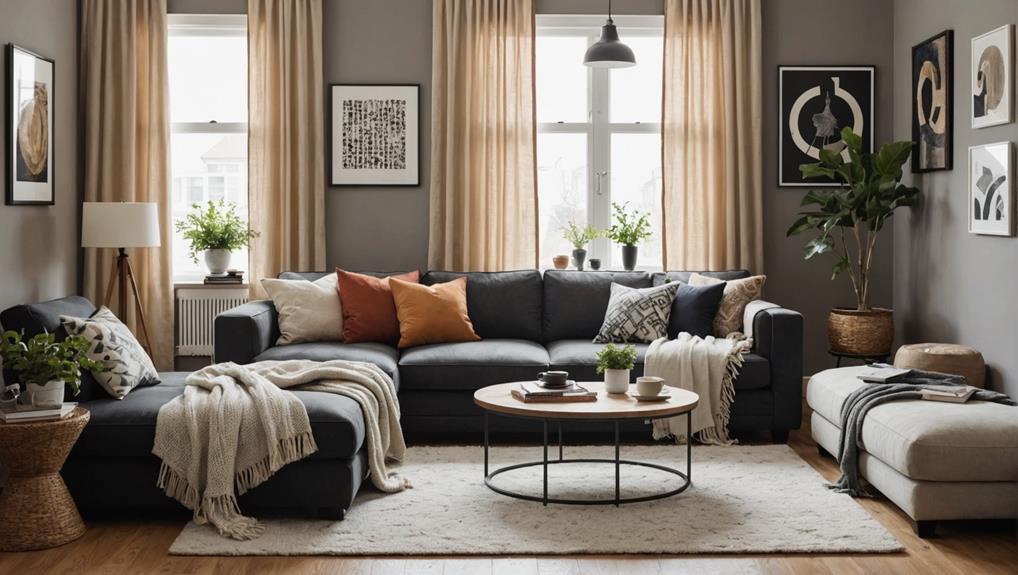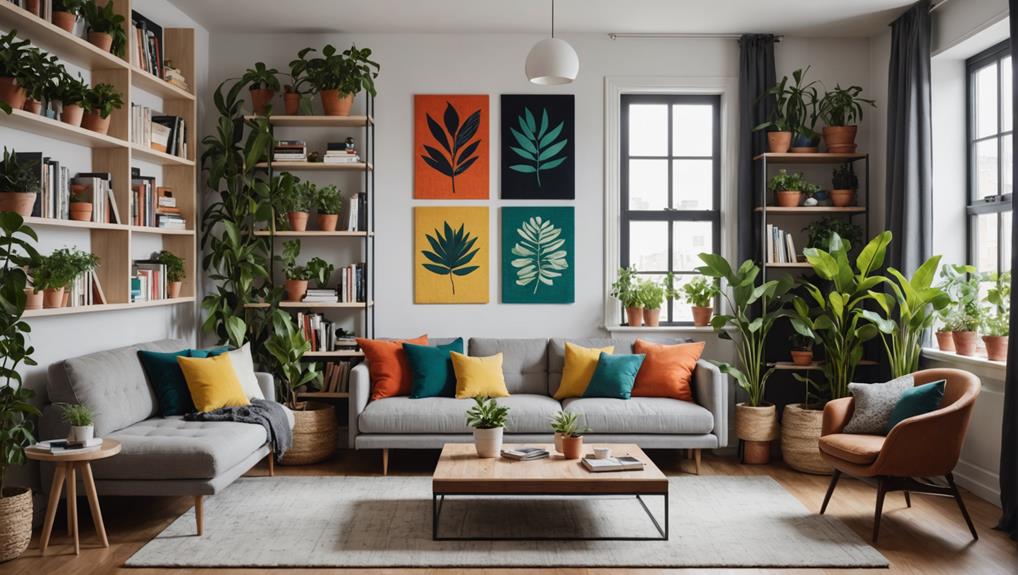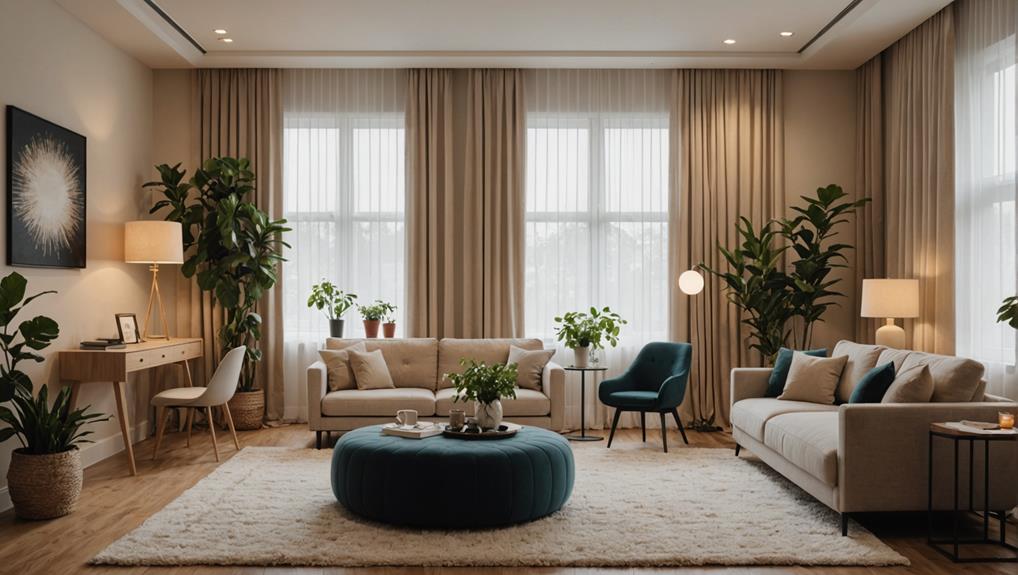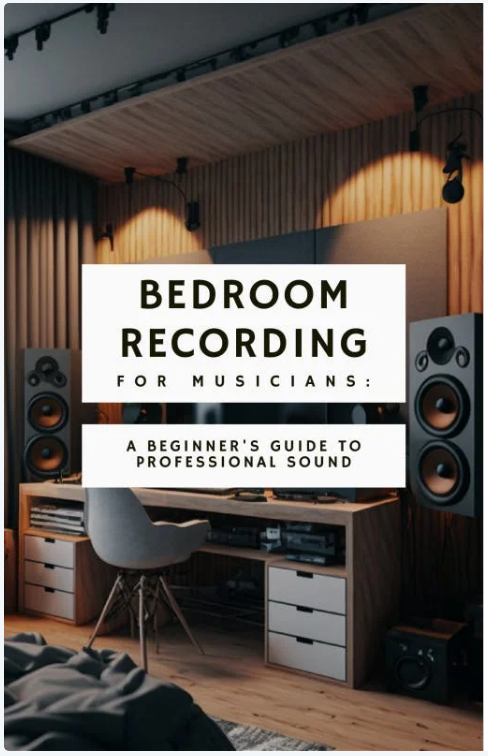To minimize echo in small rooms, use a combination of acoustic treatments and soft furnishings. Install acoustic panels or bass traps to reduce sound reflections effectively. Thick curtains and area rugs can absorb up to 50% of sound energy, enhancing clarity. Arrange furniture strategically, positioning it away from walls to disrupt sound waves. Incorporating fabric wall art or layered textiles can further dampen noise. Consider DIY solutions, like homemade sound-absorbing panels or repurposed rugs for added absorption. These techniques create a more inviting atmosphere and improve overall sound quality, leading to a more enjoyable experience. Discover additional strategies to enhance your space.
Key Takeaways
- Use acoustic panels and bass traps to absorb sound waves and reduce echo effectively in small rooms.
- Incorporate thick curtains and area rugs to dampen sound reflections from hard surfaces.
- Arrange furniture strategically to disrupt sound pathways and minimize reflections contributing to echo.
- Utilize soft furnishings like cushions and upholstered furniture to enhance sound absorption.
- Implement DIY solutions, such as sound-absorbent panels and repurposed rugs, for budget-friendly acoustic improvements.
Understanding Echo in Small Rooms
Echo can be a frustrating challenge in small rooms, as it compromises sound clarity and intelligibility. In these confined spaces, sound waves bounce off hard surfaces, leading to noticeable reflections that distort what you hear.
The impact of reverberation is heightened in small rooms, causing sound to linger longer and creating a confusing auditory environment. To improve your recording quality, consider implementing acoustic treatment techniques designed to minimize unwanted sound reflections.
When you have parallel walls, the echo effects can worsen, amplifying specific frequencies and contributing to unwanted sound buildup. To combat this issue, consider the role of soft furnishings.
Items like rugs and curtains can greatly dampen sound reflections, helping to reduce echo effectively. These materials absorb sound energy, minimizing the reflections that lead to confusion.
Additionally, utilizing acoustic panels strategically placed on walls can further enhance sound absorption. These panels are designed to absorb sound waves, greatly improving the acoustic quality in small rooms.
Acoustic Treatment Options
To effectively reduce unwanted sound reflections in small rooms, you can explore a variety of acoustic treatment options tailored to your specific needs.
Implementing proper acoustic treatment techniques is essential for achieving high-quality recordings. Here are some effective strategies:
- Acoustic Panels: Install fabric-wrapped or foam panels on walls. These can achieve noise reduction coefficients (NRC) of up to 0.95, considerably minimizing echo.
- Bass Traps: Place bass traps in corners to target low-frequency sound waves. This helps improve overall sound clarity and balance, reducing muddiness in the room.
- Thick Curtains and Area Rugs: Use heavy curtains to absorb up to 50% of sound energy and area rugs to dampen echoes from hard surfaces. These soft furnishings enhance sound absorption effectively.
- Furniture: Incorporate tall bookshelves filled with books. They scatter sound waves and serve dual purposes for storage and sound absorption, further helping to reduce echo.
Utilizing Soft Furnishings

Incorporating soft furnishings into your small room design can greatly enhance acoustic performance by absorbing sound waves. These elements play a vital role in reducing echo by minimizing sound reflections.
Start with thick curtains; they cover windows and offer significant noise absorption, especially in rooms with hard surfaces. Additionally, utilizing acoustic panels can further improve sound capture and minimize reflections, creating a more peaceful environment for recording or relaxing effective sound capture.
Adding area rugs or carpets can also dampen sound effectively, particularly in spaces with tall ceilings. These soft surfaces create a barrier that reduces echo levels.
Layering soft textiles, such as throws and decorative pillows, not only enhances comfort but also contributes to overall noise absorption, creating a cozier atmosphere.
Opt for upholstered furniture instead of hard surfaces. The fabric and padding in upholstered items trap sound waves, preventing them from bouncing around the room.
Additionally, consider hanging fabric wall art or tapestries. These pieces serve dual purposes by adding aesthetic appeal while absorbing sound, further minimizing echo in small spaces.
Strategic Room Arrangement
To effectively minimize echo in small rooms, you need to pay close attention to furniture placement and the use of soft textiles.
Positioning your furniture to create cozy, enclosed spaces can disrupt sound waves and reduce reflections.
Additionally, incorporating soft fabric items throughout the room will help absorb sound, further enhancing clarity.
Furniture Placement Techniques
One effective way to minimize echo in small rooms is by strategically arranging your furniture. Proper furniture placement can greatly reduce echo, helping you create a more acoustically friendly environment.
Here are some techniques to contemplate:
- Position furniture away from walls: This minimizes sound reflections that contribute to echo.
- Use tall bookshelves filled with books: They scatter sound waves and act as natural sound diffusers, enhancing overall acoustics.
- Arrange soft fabric furniture: Place couches and chairs in corners where sound energy accumulates to absorb sound and reduce echo.
- Incorporate rugs on hard floors: Rugs soften those hard surfaces, dampening sound reflections and creating a cozy atmosphere.
Additionally, avoid placing large furniture pieces directly against parallel walls, as this can create flutter echoes.
Instead, mix furniture sizes and shapes to disrupt sound pathways, ensuring your space feels inviting and comfortable.
Utilize Soft Textiles
After optimizing furniture placement, consider utilizing soft textiles to further enhance your room's acoustics. Incorporating items like heavy curtains, blankets, and cushions can greatly absorb sound waves, reducing echo by preventing sound reflections off hard surfaces.
Layering area rugs or carpets on bare floors is also essential; they help soften those hard surfaces, providing better sound absorption—especially beneficial in spaces with tall ceilings.
Strategically placing upholstered furniture, such as sofas and armchairs, disrupts sound waves and absorbs noise, creating a cozier environment while minimizing echo.
In addition, consider hanging tapestries or acoustic panels on your walls; these not only serve aesthetic purposes but also add soft surfaces that absorb sound, mitigating echo in small spaces.
Utilizing a combination of these soft textiles—like decorative pillows, wall hangings, and upholstered pieces—creates a balanced acoustic environment.
This approach enhances comfort and guarantees effective noise reduction, making your small room feel more inviting and less reverberant.
Creative DIY Solutions

Creating an acoustically friendly environment in small rooms can remarkably enhance your listening experience, and several DIY solutions can help achieve this goal.
By incorporating these creative solutions, you can effectively reduce echo and improve sound quality.
- DIY sound-absorbent panels: Construct panels using rockwool and wood for around $25 each. These will greatly absorb sound and minimize echo.
- Heavy blankets and tapestries: Hang these on walls to dampen sound reflections. The thicker the material, the better it absorbs sound.
- Repurpose rugs: Display old rugs or thick carpets on walls. They not only absorb sound but can also enhance the room's aesthetics.
- Foam mats: Use foam mats or interlocking tiles on your floor to create a soft surface that absorbs sound. Layer area rugs on top for additional sound dampening.
Additionally, consider positioning tall bookshelves filled with books against walls. They scatter sound waves and serve dual purposes as functional storage while minimizing echo.
Implementing these solutions will create a more pleasant auditory environment in your small room.
Budget-Friendly Acoustic Improvements
Utilizing budget-friendly acoustic improvements can drastically enhance sound quality in small rooms without breaking the bank.
Start with an area rug; thicker options effectively absorb sound waves, greatly reducing echo. Adding soft furnishings like cushions and throws not only enhances your room's aesthetic but also provides additional sound absorption.
DIY acoustic panels made from rockwool and wood are another cost-effective solution. At around $25 each, these panels can be strategically placed on walls to minimize echo.
Consider hanging heavy curtains, particularly those made of velvet or thick cotton, as they enhance sound absorption and reduce reflections from windows and walls.
Utilizing tall bookcases filled with books serves a dual purpose, as they scatter sound waves, further contributing to echo reduction while providing valuable storage.
By combining these elements, you can create an inviting and acoustically balanced environment.
These budget-friendly options allow you to effectively absorb noise and improve the overall sound quality in your small room, making it a more enjoyable space for both relaxation and conversation.
Conclusion
By implementing these strategies, you can transform your small room from an echo chamber into a serene oasis. Imagine the difference: soft textures absorbing sound, furniture arranged for ideal acoustics, and creative DIY projects that enhance both aesthetics and function. With just a few thoughtful changes, you'll experience clearer conversations and a more inviting atmosphere. Embrace these effective methods, and you'll enjoy a space that feels not only comfortable but also acoustically balanced.


